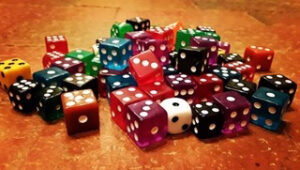 by Laura Gonzales, Education & Volunteer Manager
by Laura Gonzales, Education & Volunteer Manager
Hello from your History Herald! “Play is the highest form of research.” – Albert Einstein.
When you were a kid did you ever play “bones”? Ever wonder why dice (and often dominoes, which are also called “tiles”) are called “bones”? You guessed it! Because they were originally made from the ankle bones of animals. Early civilizations used bones, hooves and horns from animals like sheep or deer. Carved into cubes, small circles were then inscribed on the bone dice to delineate the differing sides. Did you know that those small circles actually have a name? The dots on dice are called “pips.” Did you further know that on a 6-sided dice, opposite sides always add up to lucky number 7?!
Dice are some of the oldest gaming implements known to mankind, dating back at least 5,000 years! Some of the oldest known dice were discovered at an archaeological site in the Middle East as part of a Backgammon set. But the first dice throwers weren’t gamers, they were religious figures who used them, as well as rocks, sticks, or even animal entrails, for fortune-telling. The journey from divination to gaming is unknown, but it seems that since the outcome of fortune-telling was complex, and well, a gamble, it made sense for them to “roll” into the gaming scene.
Dice games eventually made their way into New Mexico, where pieces were crafted from bone or wood until manufactured dice were brought over during the latter part of the 19th century. Like marbles, quoits, pick-up six, jacks, and more, dice have been a favorite pastime for generations! Make sure that amid your at-home learning and hands-on history, you take some time to play!

